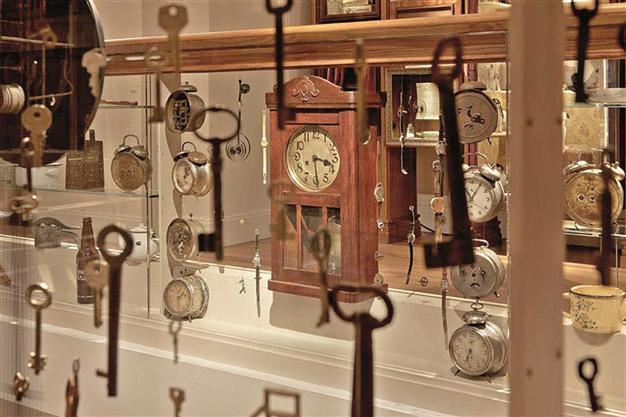Orhan Pamuk's Museum of Innocence celebrates first anniversary
ISTANBUL - Hürriyet Daily News

The museum presents scenes depicting Istanbul’s past with collages of old Turkish movies, along with other features, such as the sound of ticking clocks.
The Museum of Innocence, defined as “where Time is transformed into Space,” is celebrating its first year.
The museum was imagined “word by word, item by item, picture by picture over a very long term” by Orhan Pamuk, and has been open one year, four years after the release of his novel “The Museum of Innocence” in 2008.
During this year, 40,000 people have visited the museum, and now it is considered to be the most-mentioned Turkish museum in the world press. A total of 15,000 of these visitors were international, and 10,000 were students. On the other hand, 6,500 of the visitors had their ticket stamped on the last chapter of their books and visited the museum for free. The visitors have bought Füsun’s earrings and Kemal’s broken heart along with posters and postcards in the museum shop. The most frequently asked question to the museum staff was about the missing photographs of Füsun and Kemal.
The museum has also attracted arts professionals – artists, curators and arts managers – as an artistic installation and with the new understanding that it has innovated in the field of museology.
The museum has been also visited by leading names of contemporary art and literature such as Glenn Lowry, director of MOMA (New York); Dr. Achim Borchardt-Hume, director of exhibitions at TATE (London); Carolyn Christov-Bakargiev, curator of the 13th Documenta; Catherine De Zegher, curator of the 5th Moscow Biennial; and Umberto Eco. As Eco was accompanied by Pamuk on a tour of the Museum of Innocence, he paid most attention to the “East-West” Clock and once more proved that he is a good reader when he asked why Füsun’s earring was missing from Box No. 47.
Following the nomination of Museum of Innocence for the architecture category of the Designs of the Year Awards of the Design Museum London, the replica of Box No. 14 (Edition 1/5) “Istanbul’s Streets, Bridges, Hills, and Squares” is being exhibited at the Design Museum with the support of the British Council. In addition, the 26th chapter of the Museum of Innocence ‘An Anatomical Chart of Love Pains’ has been the source of inspiration for an exhibition opened on April 13 in a contemporary art space named Model in Ireland.
The visitors who come to the museum to see this love story, to remember and cherish the memory of a lost city and also to “console themselves with the things” will be able to hear the story of the museum in the voice of Pamuk with audio guides that will be available as of June.
Reading Kemal Basmacı’s words, “Museums: 1. They are not for visiting, but for feeling and living,” visitors have come to the museum, located in a historical building made in 1897, and found many forgotten details of the époque 1950-2000 in Istanbul. They found gas lamps in Box No. 10, “City Lights and Happiness;” pictures of actors and football players rolled in chewing gum in Box No. 12, “Kissing on the Lips”; the ships of Istanbul in Box No. 41 “Swimming on My Back”; the favorite family game bingo in Box No. 58; and the passion of Turkish Classical Music in Box No. 67 “Cologne.” Lovers sat hand in hand in the penthouse where Basmacı lived between 2000 and 2007 and which contains the last four chapters of the novel.
Visitors have viewed scenes depicting Istanbul’s past from the collages of old Turkish movies pleasantly listening to the ferry horns, clock ticking, footsteps of people walking on the pavement, children playing or music of taverns and sounds of people dining at restaurants at the Museum of Innocence, which is also a hub for the sounds and scenes of the city.
Visitors who traveled from different corners of the world only to see the museum inscribed their feelings in the memory book of the museum. Those grateful for the existence of a museum that cherishes Füsun’s memory and immortalizes the story described the museum as “a temple created for the power of the word” and confronting “not only a love story but also the story of a city.”
